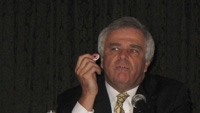TV and wireless industries square off over spectrum policy — Part 2

Editor’s note: Part 1 of this story, “TV, wireless industries square off in D.C. over spectrum policy – Part 1,” is available on the Broadcast Engineering website.
A policy forum last week in Washington, D.C., crystallized the problem TV broadcasters and the mobile phone/wireless industry are sure to have as they grapple to find a way to clear television spectrum for future wireless broadband Internet use.
During the Broadband Policy Summit VI June 11, Christopher Guttman-McCabe, vice president, regulatory affairs at CTIA-The Wireless Association, and David Donovan, president of the Association for Maximum Service Television, squared off to debate whether or not broadcast spectrum should be converted for wireless Internet use.
With the FCC’s National Broadband Plan calling for broadcasters to give 120MHz of their spectrum voluntarily via incentive auctions that share auction proceeds with broadcasters, the debate provided a forum for both sides to air their positions.
Guttman-McCabe emphasized the need for spectrum, saying that by 2015 a total of 280 million smart phones will be in use in the United States. By repacking the bands with spectrum freed up from voluntary givebacks from broadcasters and other spectrum users, the wireless industry will be able to meet this demand.
Donovan stood firm. “Why would you want to embrace a model that takes essentially 40 percent or half of the spectrum away from local television stations that in fact are providing this in a point-to-multipoint or one-to-many architecture, which from a technical standpoint is ideally designed to handle this type of video?” he asked rhetorically. “I guess the short answer is you charge by the minute for it.”
Guttman-McCabe questioned why wireless carriers should support mobile DTV when consumers have voted with their billfolds and increasingly shunned over-the-air television in favor of pay-TV services, such as cable and satellite. Consumers have turned away from free OTA television to the point that it might be in its “last, waning” days, he said.
Get the TV Tech Newsletter
The professional video industry's #1 source for news, trends and product and tech information. Sign up below.
Donovan countered that the decline in OTA households has been exaggerated. Guttman-McCabe, however, said the trend in media is away from OTA and to social media and interacting via portable devices. “What young folks are doing is all mobile,” he said. Pointing to the inauguration of President Barack Obama, Guttman-McCabe said there was such a spike in video uploads of the ceremony and festivities to social media sites that it appeared the sites were experiencing an attack. Donovan replied that the sources of that video were traditional television networks and channels, all of which would be accessible from a mobile DTV-equipped device.
Both Donovan and Guttman-McCabe agreed there is a need for a spectrum inventory to identify availability and usage, but there, too, the pair had their differences. Donovan asked Guttman-McCabe if he would agree to postpone any spectrum reallocation until after the completion of such an inventory. Guttman-McCabe declined.
For all of the rancor, Guttman-McCabe held out an olive branch. “I do want to work with David and his group,” he said. “I think we can work through these issues.”
For his part, Donovan said conducting a nationwide spectrum inventory is “a prerequisite” before moving forward. The danger of “plowing ahead” without first taking stock of how the spectrum is used is a threat to the future of mobile DTV. “If you take 40 percent of our spectrum away, you kill this [mobile DTV] before it gets started,” said Donovan.
Phil Kurz is a contributing editor to TV Tech. He has written about TV and video technology for more than 30 years and served as editor of three leading industry magazines. He earned a Bachelor of Journalism and a Master’s Degree in Journalism from the University of Missouri-Columbia School of Journalism.

